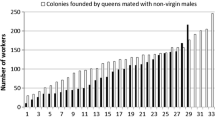Summary
Many females morphologically intermediate between queens and workers were found in a northernmost population ofMyrmecina graminicola nipponica Wheeler. Dissection and morphological observation revealed that there were three categories of intercastes. Major intercastes were as large as queens in body size, with seven or more ovarioles, but had only one ocellus, unlike queens, which had three ocelli. Medium intercasts had an enlarged mesonotum, one or no ocellus and 2 to 12 ovarioles. Minor intercaste was very simlar to workers in external morphology, but had a spermatheca, unlike workers. Inseminated females constituted 75%, 40% and 28.6% in the major, medium and minor intercastes respectively. Many of the virgin medium and minor intercastes had a small disfunctional spermatheca.
In queenright colonies, a single queen was inseminated and had an active ovary. In queenless colonies where the intercastes reproduced, however, some colonies were functionally monogynous, but the others polygynous. The ratio of polygynous colonies to monogynous colonies was lowest in July and highest in September, suggesting that polygyny results from newly inseminated intercastes remaining in their natal nests, although they leave those nests in the season of colonial budding. Queenless colonies containing inseminated intercastes exclusively produced intercastes, while queenright colonies almost exclusively produced queens.
Similar content being viewed by others
References
Buschinger, A., 1970. Zur Frage der Monogynie oder Polygynie beiMyrmecina graminicola (Latr.) (Hym., Form.).Ins. Soc. 17:171–182.
Buschinger, A., 1979. Functional monogyny in the American guest antFormicoxenus hirticornis (Emery) (=Leptothorax hirticornis), (Hym., Form.).Ins. Soc. 26:61–68.
Buschinger, A. and U. Winter, 1975. Der Polymorphisms der sklavenhaltenden AmeiseHarpagoxenus sublaevis (Nyl.) (Hym., Form.).Ins. Soc. 22:333–362.
Buschinger, A. and U. Winter, 1976. Funktionelle Monogynie bei der GastameiseFormicoxenus nitidulus (Nyl.) (Hym., Form.).Ins. Soc. 23:549–558.
Collingwood, C. A., 1979.The Formicidae (Hymenopterd) of Fennoscandia and Denmark. Fauna Entomologica Scandinavia Vol. 8, Scandinavian Science Press Ltd, Klampenborg, Denmark. 174pp.
Forel, A., 1915. Die Ameisen der Schweiz. In:Fauna Ins. Helvetica (Hym. Form.).Beil, zu Mitt. Schweiz. Entoml. Ges.: 1–77.
Heinze, J. and A. Buschinger, 1987. Queen polymorphism in a nonparasiticLeptothorax species (Hymenoptera: Formicidae).Ins. Soc. 34:28–43.
Heinze, J. and A. Buschinger, 1989. Queen polymorphism inLeptothorax spec. A: its genetic and ecological background (Hymenoptera: Formicidae).Ins. Soc. 36:139–155.
Herbers, J. M., 1986. Nest site limitation and facultative polygyny in the antLeptothorax longispinosus.Behav. Ecol. Sociobiol. 19:115–122.
Peelers, C., 1991. Ergatoid queens and intercastes in ants: two distinct adult forms which look morphologically intermediate between workers and winged queens.Ins. Soc. 38:1–15.
Tsuji, K., T. Fukukawa, K. Kinomura, H. Takamine and K. Yamauchi, 1991. The caste system of the dolichoderine antTechnomyrmex albipes (Hymenoptera: Formicidae): morphological description of queens, workers and reproductively active intercastes.Ins. Soc. 38:413–422.
Winter, U. and A. Buschinger, 1986. Genetically mediated queen polymorphism and caste determination in the slave-making ant,Harpagoxenus sublaevis (Hymenoptera: Formicidae).Entomol. Gener. 11:125–137.
Author information
Authors and Affiliations
Rights and permissions
About this article
Cite this article
Ohkawara, K., Ito, F. & Higashi, S. Production and reproductive function of intercastes inMyrmecina gvaminicola nipponica colonies (Hymenoptera: Formicidae). Ins. Soc 40, 1–10 (1993). https://doi.org/10.1007/BF01338828
Received:
Revised:
Accepted:
Issue Date:
DOI: https://doi.org/10.1007/BF01338828




